The Checker Maven
North Dakota

North Dakota! The very name conjures images of snow and cold, and winters that seem to go on forever. Indoor activities definitely dominate the scene during the winter months.
It's no surprise, then, that North Dakota for many years had a very active checker scene, producing a well-regarded checkers magazine, and contesting numerous tournaments including a regular state championship.
The current state champion is Larry Atwood, a mathematics teacher at Minot State University in Minot, North Dakota (we were unable to find out by press time how long Mr. Atwood has held this title, though we think it's quite a little while).
In today's column, we go back in North Dakota history to the time of a player with a most checker-like name, Howard King. We don't have any information on Mr. King other than our supposition that he was a North Dakota checkerist in the first half of the 20th century. However, Mr. King is credited with the problem shown below.
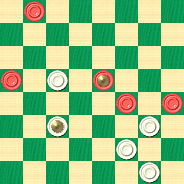
WHITE
White to Play and Draw
W:W32,27,24,K22,14:B20,19,K15,13,1.
Black has just played 16-19, striving for the win with a clever trap. But White has an instructive draw here if he doesn't fall into Black's snare. This is definitely one of our more difficult problems, but the solution is there, and illustrates a very important point in checker play.
Don't be left out in the cold or stay in the dark; find the moves that save the draw. But if you find yourself snowed in, you can always click on Read More to dig out the solution.![]()
A Quiet Scene

The scene shown above is certainly quiet and idyllic. It's hardly the place you'd expect to find drama and excitement.
But then again, one never knows.
A checkerboard analogy, shown below, will demonstrate our point.
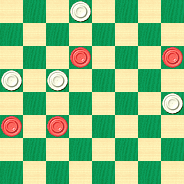
BLACK
Black to Play and Draw
B:W31,20,19,13:B23,21,12,11.
What do we have here? The White men on 19 and 20 and the Black men on 11 and 12 are holding each other off. So is the White man on 31 and the Black man on 23. Black's man on 21 can go in for a King, as can the White man on 13. Looks like a pretty quiet setup. What are we missing? Oh ... yes ... take a closer look at the Black man on 11. After White gets a king that Black man might be in real danger.
It's said that quiet little villages have their secrets. The same is true for checkerboard positions. Black does indeed have a draw, but like closely held secrets, you'll have to dig it out.
When you've unearthed the solution, or did all the digging you wish to do, click on Read More to see the surprising answer.![]()
Make John Acker Go Away!

Checker fans around the world know and appreciate John Acker's efforts to bring us the best in checker tournament reporting. In 2011, John took his coverage to a new level providing live internet streaming of the Moiseyev - Borghetti world championship match.
This coming June, Alex and Michele will meet again to contest the world 3-move championship, with the venue moving from the US to Italy.
John naturally plans to be on hand to provide professional quality coverage of the event, including another live video stream.
The only problem is that this will be an expensive undertaking, running to about two months of John's salary. John is requesting the help of checker fans to defray these costs. Just a few dollars each from potential viewers would make a big difference.
Please help make John Acker "go away" to Italy! John explains how you can do just that:
"Thanks in advance for your consideration--- feel free to contact me at acker.jt@gmail.com or 217-778-3451 if you have any questions. As always, you can donate online via the ACF Store (http://www.usacheckers.com/store), or you can send a check or money order to the ACF at P.O. Box 3488, Columbus, OH 43210-3488. Just write "Acker travel fund" on your check, so we know where you want the money to go. I'm really looking forward to visiting Italy, and to making this the best World Championship Match yet!"
![]()
Do As I Say

"Do as I say, not as I do" is an old expression that finds application all too often. We can think of far too many examples to list here, so we'll just invite you to use your imagination.
In a scientific game such as checkers, though, it would seem that such a catchphrase has little application. After all, checker moves speak for themselves; they're either good or they're not. But bear with us; following the solution to today's problem you'll find a hilarious example of one man's version of "Do as I say" over the checkerboard.
The position, part of our Checker School series, is subtle and pleasing, and as usual, highly practical.
WHITE
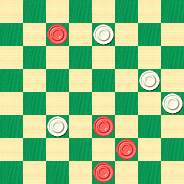
BLACK
Black to Play and Win
B:W26,17,13,11:B27,10,6,2.
It's harder than it looks. Can you solve it? When you've found your solution, click on Read More to check your answer and play through a sample game with explanatory notes.![]()
Diagonal Diagnosis
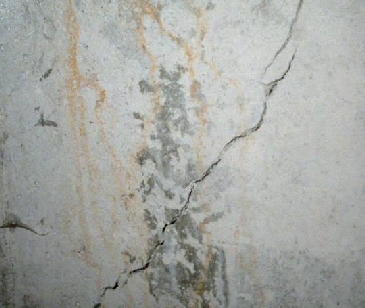
Editor's Note: This column has been substantially corrected thanks to correspondence from checker expert Al Lyman.
The photo above shows a nasty diagonal crack in the foundation of someone's house. That's going to be an expensive problem but it's best to diagnose and fix it before it gets worse.
As we mentioned in our previous installment from Willie Ryan's Tricks Traps & Shots of the Checkerboard, we're getting toward the end of the book and Willie's examples have turned even more complex than ever. In today's installment, Willie, who lacked powerful 21st century computing capabilities, had a few of his own diagonal cracks in the foundation of his analysis. Still, it's hard to fault such a brilliant man; he was doing everything in his head with no silicon monsters to help him out, and he got it right far more often than not.
Today, we're asking you to repair the cracks, and we understand that that's a tall order indeed. But we think you'll enjoy and benefit from our revised analysis, all of which is attributed to Ed Gilbert's KingsRow computer engine and 10-piece endgame database. Think what Willie would have done with such fabulous tools. No more patching by hand!
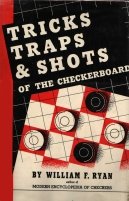
| 9-13 | 18-9 | 13-22 | 1-5 | 12-16 |
| 21-17 | 5-14 | 20-16* | 11-15 | 17-13 |
| 11-15 | 24-20---I,4 | 11-18---O | 5-9 | 18-23 |
| 25-21 | 3-8---J | 19-15 | 8-11 | 24-20---9 |
| 8-11 | 28-24 | 10-28 | 27-24 | White |
| 23-18---1 | 1-6*---K | 30-26 | 4-8 | should |
| 6-9---2 | 23-19*---5 | 12-19 | 21-17 | win. |
| 26-23---A | 15-18---N,6 | 26-1*---P | 8-12 | Wm. F. |
| 9-14---B,3 | 22-15 | 7-11---7 | 29-25---8 | Ryan. |
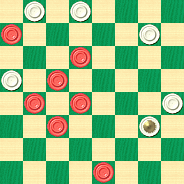
BLACK
Black to Play and Draw
B:W32,31,25,20,13,K9:B28,23,19,16,15,11,2.
A---"The orthodox continuation here is: 27-23, 9-14, 18-9, 5-14, 30-25, 1-6, 24-19, etc. While the 26-23 line is not so safe, it is sound enough, and is considerably more productive of wins than the conservative 27-23 development.
B---3-8 is stronger at this point and has been published erroneously as a play to win for black. The following outline charts the course to safety for white:
| 3-8 | 32-27* | 6-9 | 23-18 | 19-23 |
| 23-19* | 1-6 | 31-27---G | 27-24 | 2-7 |
| 11-16---C | 30-26* | 7-10 | 18-15 | 23-18 |
| 18-11 | 10-15---E | 28-24 | 24-19 | 1-6 |
| 16-23 | 20-16* | 19-28 | 15-10---H | 18-25 |
| 27-18 | 2-1---F | 27-24 | 4-8 | 7-10 |
| 8-15 | 27-23* | 12-19 | 6-1 | 13-22 |
| 18-11 | 15-18 | 24-6 | 8-11 | 6-13* |
| 7-16---D | 23-14* | 28-32 | 10-6 | Drawn. |
| 24-20* | 9-25 | 26-23 | 11-15 | Wm. F. |
| 16-19 | 29-22 | 32-27 | 6-2 | Ryan. |
C---If the moves are: 9-14, 18-9, 5-14, then the draw is reached with: 30-25*, 11-16, 24-20, 15-24, 28-19,16-23, 27-9,1-5,17-14, 10-26, 31-22, 5-14, 22-17, 13-22, 25-9. Wm. F. Ryan.
D---Abandoned here by P. H. Ketchum without further play. He judged the situation to be strong for black, if not a win. The route to a draw from this point involves instructive analysis.
E---4-8 is a low-pressure alternative and barely gains a draw, viz: 4-8, 27-24*, 2-7, 24-15, 10-19, 22-18*, 13-22, 26-17, 9-13*, 17-14, 6-9*, 29-25, 8-11*, 31-27, 19-23, 27-24, 13-17, 24-19, 17-22, 21-17, 22-29, 17-13, 29-25, 13-6, 23-26, 6-1, 25-21, 1-6, 21-17, 6-10, 5-9, 10-3, 17-10, 3-8, 10-14. Wm. F. Ryan.
F---Or 6-10, 27-24, 9-14, 16-11, 12-16, 31-27*, 5-9, 29-25*, 16-20, 11-7, 2-11, 27-23, 20-27, 23-7, 27-31, 26-23, 31-27, 23-19, 15-24, 28-19, which also produces a draw. Wm. F. Ryan.
G---A more difficult draw may be effected with careful play by 22-18,13-22, 26-17, 9-13, 17-14, 19-23, 18-15, 12-19,15-10, 5-9, 10-3, 9-18, 3-7, 18-22, 7-10, 22-25, 10-15, 4-8, 15-24, 8-12, 24-20, 25-29, 28-24. Wm. F. Ryan.
H---The position is now clearly a draw, but we continue the play to illustrate a fancy as well as feasible finish.
I---White has the best looking board, with virtually all of the winning chances in his favor.
J---The build-up by 4-8, 28-24, 1-6, 23-18 is a creaky combination for black, but 15-19, 23-16, 12-19 will do well; at this point, continue with: 27-24, 10-15* (not 11-15, 22-18*, 15-22, 24-6, 1-10, 32-27 *, etc., as white will win; I have victimized many a player with this scheme) 17-10, 7-14, 30-26, 2-7, 32-27, 4-8, 27-23* (not 22-17, 13-22, 26-10, 7-14, 31-26, 14-18, 26-22, 18-25, 29-22, 1-5, 21-17, 5-9, 17-13, 9-14, 13-9, 14-18, 22-17, 19-23, as black will win. Paul Thompson); 8-12, 23-16, 12-19, 22-17, 13-22, 26-10, 7-14, 31-26*, 14-18, 26-22, 18-25, 29-22, 19-23, 24-19, 15-24, 28-19, 23-26, 22-18, 26-30, 19-16, 30-25, 16-7, 3-10, 21-17, ending in a draw. Wm. F. Ryan.
K---Black's only move to draw. The three alternatives, 1-5, 11-16, and 12-16, all lose in short order as follows:
| 1-5---L | 15-24 | 10-19 | 13-17 | 12-16 |
| 30-25* | 27-11* | 17-10 | 21-5 | 31-26 |
| 5-9---M | 8-15 | 19-23 | 30-21 | 16-19 |
| 32-28* | 23-19* | 10-6* | 18-14 | 26-22 |
| 11-16 | 15-24 | 23-26 | 21-17 | 19-23 |
| 20-11 | 28-19 | 6-1 | 14-9 | 29-25. |
| 7-16 | 4-8 | 26-30 | 17-14 | White |
| 24-19* | 19-15 | 22-18 | 1-6 | wins. |
L---If the play goes: 11-16, 20-11, 7-16, white triumphs with 23-18, 14-23, 27-11, 8-15, 30-26, 16-20, 17-14, 10-17, 21-14, 20-27, 31-24. Again at L, if 12-16 is the play, white romps home first with: 23-19, 16-23, 27-9, 1-5, 9-6, 2-9, 30-26, 9-14, 26-23, 8-12, 35-19, 14-18, 29-25, 5-9, 32-27, 9-14, 31-26, 4-8, 26-23. Wm. F. Ryan.
M---Against 11-16, 20-11, 7-16, white executes a very unique clean-out and wins with: 23-19*, 16-23, 27-9, 5-14, 22-18*, 14-23, 31-27, 13-22, 25-11, 8-15, 27-11.
N---Loses, and white snaps the trap shut with a startling stroke, which has claimed many a champion. I was caught by this one several times before I came to recognize it; and I saw Newell W. Banks entrapped by it as well. The following play at N assures a draw and makes white run hard for home: 6-9*, 30-25*, 11-16, 20-11, 7-23, 27-11, 8-15, 24-19*!, 15-24, 32-28, 24-27, 31-24, 12-16, 24-20, 16-19, 20-16, 4-8, 16-12, 8-11, 12-8, 11-15, 8-3, 19-24, 28-19, 15-24, 3-8, 2-7, 8-12, 24-27 (not 7-11, 22-18!, as white will win), 12-16, 27-31, 16-19, 7-11, 19-15, 10-19, 17-10, 31-27, 10-6, 27-23, 6-1, 19-24, 21-17, 23-26, 25-21, 26-30, 1-6, 11-15, 6-10, 15-19. Wm. F. Ryan.
O---11-20, 19-16, 12-28, 30-26, 10-19, 17-1* is no better, and also loses. The important point is to take the stroke into square one, and not to three, as the ending with the king on square three cannot be scientifically won.
P---White now has a free hand with his king. Black cannot crack the line without the loss of a piece, and subsequently loses because his position deteriorates. Although the stroke following black's 15-18 move at JV has been published several times, I can find no record of it being properly executed. Invariably, white has made the mistake of jumping into square 3 at Note P. I make no claim for the play prior to the shot, but its proper execution, as revealed in this study, as well as its attending formational structures discussed in the notes, are my contributions to an outstanding, brilliant, and practical stroke."
1---30-25 is substantially better here---Ed.
2---4-8 would have been preferable---Ed.
3---While 3-8 can't be called "winning" it certainly gives Black an edge---Ed.
4---Willie's comment is hard to understand as the computer finds this position to be dead even. Perhaps White is stronger in practical over the board play.
5---Why Willie stars this move baffles us; far from winning, it gives Black the advantage! 32-28 was the right move here---Ed.
6---This is not actually a losing move---Ed.
7---8-11 is best; White now has a solid edge---Ed.
8---While White can't be said to have a clear win, 24-20 was correct here. The game is now a draw.---Ed.
9---The game is definitely a draw according to the computer; we don't see Willy's win for White at all---Ed.
Can you demonstrate the draw for Black here? Fix the crack in the problem and then click on Read More to check your solution.![]()
A Gentle Stroke

We've often said that stroke problems are not for everyone, but a gentle stroke of the type shown above (yes, we've done this theme before) is pleasing to almost everyone.
The stroke problem below has fewer pieces than is typical for problems of this type, and is in fact quite a lot more gentle than many others. See how fast you can solve it from the diagram, without setting up a board or moving the pieces.
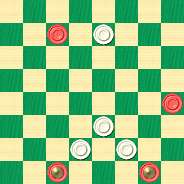
WHITE
White to Play and Win
W:W7,23,26,27:B6,20,K30,K32.
When you've found the solution, click your mouse (gently, of course) on Read More to verify your answer.![]()
